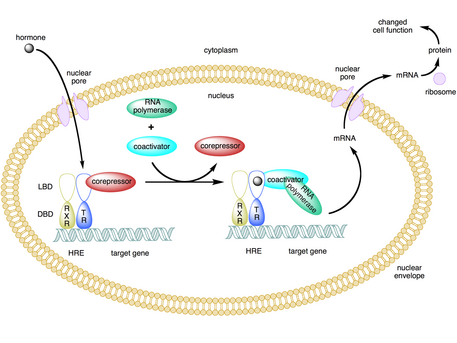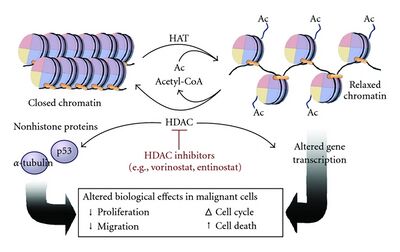Biology:Coactivator (genetics)

A coactivator is a type of transcriptional coregulator that binds to an activator (a transcription factor) to increase the rate of transcription of a gene or set of genes.[1] The activator contains a DNA binding domain that binds either to a DNA promoter site or a specific DNA regulatory sequence called an enhancer.[2][3] Binding of the activator-coactivator complex increases the speed of transcription by recruiting general transcription machinery to the promoter, therefore increasing gene expression.[3][4][5] The use of activators and coactivators allows for highly specific expression of certain genes depending on cell type and developmental stage.[2]
Some coactivators also have histone acetyltransferase (HAT) activity. HATs form large multiprotein complexes that weaken the association of histones to DNA by acetylating the N-terminal histone tail. This provides more space for the transcription machinery to bind to the promoter, therefore increasing gene expression.[1][4]
Activators are found in all living organisms, but coactivator proteins are typically only found in eukaryotes because they are more complex and require a more intricate mechanism for gene regulation.[1][4] In eukaryotes, coactivators are usually proteins that are localized in the nucleus.[1][6]
Mechanism
Some coactivators indirectly regulate gene expression by binding to an activator and inducing a conformational change that then allows the activator to bind to the DNA enhancer or promoter sequence.[2][7][8] Once the activator-coactivator complex binds to the enhancer, RNA polymerase II and other general transcription machinery are recruited to the DNA and transcription begins.[9]
Histone acetyltransferase
Nuclear DNA is normally wrapped tightly around histones, making it hard or impossible for the transcription machinery to access the DNA. This association is due primarily to the electrostatic attraction between the DNA and histones as the DNA phosphate backbone is negatively charged and histones are rich in lysine residues, which are positively charged.[10] The tight DNA-histone association prevents the transcription of DNA into RNA.
Many coactivators have histone acetyltransferase (HAT) activity meaning that they can acetylate specific lysine residues on the N-terminal tails of histones.[4][7][11] In this method, an activator binds to an enhancer site and recruits a HAT complex that then acetylates nucleosomal promoter-bound histones by neutralizing the positively charged lysine residues.[7][11] This charge neutralization causes the histones to have a weaker bond to the negatively charged DNA, which relaxes the chromatin structure, allowing other transcription factors or transcription machinery to bind to the promoter (transcription initiation).[4][11] Acetylation by HAT complexes may also help keep chromatin open throughout the process of elongation, increasing the speed of transcription.[4]
Acetylation of the N-terminal histone tail is one of the most common protein modifications found in eukaryotes, with about 85% of all human proteins being acetylated.[12] Acetylation is crucial for synthesis, stability, function, regulation and localization of proteins and RNA transcripts.[11][12]
HATs function similarly to N-terminal acetyltransferases (NATs) but their acetylation is reversible unlike in NATs.[13] HAT mediated histone acetylation is reversed using histone deacetylase (HDAC), which catalyzes the hydrolysis of lysine residues, removing the acetyl group from the histones.[4][7][11] This causes the chromatin to close back up from their relaxed state, making it difficult for the transcription machinery to bind to the promoter, thus repressing gene expression.[4][7]
Examples of coactivators that display HAT activity include CARM1, CBP and EP300.[14][15]
Corepression
Many coactivators also function as corepressors under certain circumstances.[5][9] Cofactors such as TAF1 and BTAF1 can initiate transcription in the presence of an activator (act as a coactivator) and repress basal transcription in the absence of an activator (act as a corepressor).[9]
Significance
Biological significance
Transcriptional regulation is one of the most common ways for an organism to alter gene expression.[16] The use of activation and coactivation allows for greater control over when, where and how much of a protein is produced.[1][7][16] This enables each cell to be able to quickly respond to environmental or physiological changes and helps to mitigate any damage that may occur if it were otherwise unregulated.[1][7]
Associated disorders
Mutations to coactivator genes leading to loss or gain of protein function have been linked to diseases and disorders such as birth defects, cancer (especially hormone dependent cancers), neurodevelopmental disorders and intellectual disability (ID), among many others.[17][5] Dysregulation leading to the over- or under-expression of coactivators can detrimentally interact with many drugs (especially anti-hormone drugs) and has been implicated in cancer, fertility issues and neurodevelopmental and neuropsychiatric disorders.[5] For a specific example, dysregulation of CREB-binding protein (CBP)—which acts as a coactivator for numerous transcription factors within the central nervous system (CNS), reproductive system, thymus and kidneys—has been linked to Huntington's disease, leukaemia, Rubinstein-Taybi syndrome, neurodevelopmental disorders and deficits of the immune system, hematopoiesis and skeletal muscle function.[14][18]
As drug targets
Coactivators are promising targets for drug therapies in the treatment of cancer, metabolic disorder, cardiovascular disease and type 2 diabetes, along with many other disorders.[5][19] For example, the steroid receptor coactivator (SCR) NCOA3 is often overexpressed in breast cancer, so the development of an inhibitor molecule that targets this coactivator and decreases its expression could be used as a potential treatment for breast cancer.[15][20]
Because transcription factors control many different biological processes, they are ideal targets for drug therapy.[14][21] The coactivators that regulate them can be easily replaced with a synthetic ligand that allows for control over an increase or decrease in gene expression.[14]
Further technological advances will provide new insights into the function and regulation of coactivators at a whole-organism level and elucidate their role in human disease, which will hopefully provide better targets for future drug therapies.[14][15]
Known coactivators
To date there are more than 300 known coregulators.[15] Some examples of these coactivators include:[22]
- ARA54 targets androgen receptors
- ATXN7L3 targets several members of the nuclear receptor superfamily
- BCL3 targets 9-cis retinoic acid receptor (RXR)
- CBP targets many transcription factors
- CDC25B targets steroid receptors
- COPS5 targets several nuclear receptors
- DDC targets androgen receptors
- EP300 targets many transcription factors
- KAT5 targets many nuclear receptors
- KDM1A targets androgen receptors
- Steroid receptor coactivator (SRC) family
- YAP targets transcription factors
- WWTR1 targets transcription factors
See also
References
- ↑ 1.0 1.1 1.2 1.3 1.4 1.5 Courey, Albert J. (2008). Mechanisms in transcriptional regulation. Malden, MA: Blackwell. ISBN 978-1-4051-0370-1. OCLC 173367793.
- ↑ 2.0 2.1 2.2 "General transcription factor / transcription factor". Learn Science at Scitable. https://www.nature.com/scitable/definition/transcription-factor-167.
- ↑ 3.0 3.1 "Enhancers: five essential questions". Nature Reviews Genetics 14 (4): 288–95. April 2013. doi:10.1038/nrg3458. PMID 23503198.
- ↑ 4.0 4.1 4.2 4.3 4.4 4.5 4.6 4.7 "The many HATs of transcription coactivators". Trends in Biochemical Sciences 25 (1): 15–9. January 2000. doi:10.1016/S0968-0004(99)01516-9. PMID 10637607.
- ↑ 5.0 5.1 5.2 5.3 5.4 Kumar, Rakesh; O'Malley, Bert W. (2008). NR coregulators and human diseases. Hackensack, N.J.: World Scientific. ISBN 978-981-270-536-5. OCLC 261137374.
- ↑ "Coactivators and general transcription factors have two distinct dynamic populations dependent on transcription". The EMBO Journal 36 (18): 2710–2725. September 2017. doi:10.15252/embj.201696035. PMID 28724529.
- ↑ 7.0 7.1 7.2 7.3 7.4 7.5 7.6 "Biological control through regulated transcriptional coactivators". Cell 119 (2): 157–67. October 2004. doi:10.1016/j.cell.2004.09.037. PMID 15479634.
- ↑ "Molecular Dynamics of "Fuzzy" Transcriptional Activator-Coactivator Interactions". PLOS Computational Biology 12 (5): e1004935. May 2016. doi:10.1371/journal.pcbi.1004935. PMID 27175900. Bibcode: 2016PLSCB..12E4935S.
- ↑ 9.0 9.1 9.2 "The general transcription machinery and general cofactors". Critical Reviews in Biochemistry and Molecular Biology 41 (3): 105–78. May 2006. doi:10.1080/10409230600648736. PMID 16858867.
- ↑ Decher, Gero (1997-08-29). "Fuzzy Nanoassemblies: Toward Layered Polymeric Multicomposites" (in en). Science 277 (5330): 1232–1237. doi:10.1126/science.277.5330.1232. ISSN 0036-8075.
- ↑ 11.0 11.1 11.2 11.3 11.4 "Nuclear receptor coregulators: multiple modes of modification". Trends in Endocrinology and Metabolism 13 (2): 55–60. 2002. doi:10.1016/s1043-2760(01)00527-6. PMID 11854019.
- ↑ 12.0 12.1 "NatF contributes to an evolutionary shift in protein N-terminal acetylation and is important for normal chromosome segregation". PLOS Genetics 7 (7): e1002169. July 2011. doi:10.1371/journal.pgen.1002169. PMID 21750686.
- ↑ "Protein N-terminal acetyltransferases: when the start matters". Trends in Biochemical Sciences 37 (4): 152–61. April 2012. doi:10.1016/j.tibs.2012.02.003. PMID 22405572.
- ↑ 14.0 14.1 14.2 14.3 14.4 "Nuclear receptor coregulators: modulators of pathology and therapeutic targets". Nature Reviews. Endocrinology 8 (10): 598–604. October 2012. doi:10.1038/nrendo.2012.100. PMID 22733267.
- ↑ 15.0 15.1 15.2 15.3 "Nuclear receptor coregulators as a new paradigm for therapeutic targeting". Advanced Drug Delivery Reviews 62 (13): 1227–37. October 2010. doi:10.1016/j.addr.2010.09.016. PMID 20933027.
- ↑ 16.0 16.1 "Enhancer". Learn Science at Scitable. https://www.nature.com/scitable/definition/enhancer-163.
- ↑ Berk, Arnold; Zipursky, S. Lawrence; Matsudaira, Paul T.; Baltimore, David; Darnell, James (2000). Molecular Cell Biology (4th ed.). New York: W.H. Freeman. ISBN 978-0-7167-3136-8. OCLC 41266312. https://archive.org/details/molecularcellbio00lodi.
- ↑ Becnel, LB; Darlington, YF; Orechsner, S; Easton-Marks, J; Watkins, CA; McOwiti, A; Kankanamge, WH; Dehart, M et al.. "CBP". NURSA Molecules. doi:10.1621/8egsudafco.
- ↑ "Nuclear Receptors". https://courses.washington.edu/conj/bess/nuclear/nuclear.htm.
- ↑ "Steroid receptor coactivator-3 as a potential molecular target for cancer therapy". Expert Opinion on Therapeutic Targets 16 (11): 1085–96. November 2012. doi:10.1517/14728222.2012.718330. PMID 22924430.
- ↑ "Nuclear receptors as drug targets: new developments in coregulators, orphan receptors and major therapeutic areas". Expert Opinion on Therapeutic Targets 7 (5): 679–84. October 2003. doi:10.1517/14728222.7.5.679. PMID 14498828.
- ↑ "NURSA - Molecules" (in en). https://nursa.org/nursa/molecules/index.jsf.
External links
- Nuclear Receptor Signalling Atlas (NIH-funded research consortium and database; includes open-access PubMed-indexed journal, Nuclear Receptor Signaling)
- TcoF - Dragon database of transcription co-factors and transcription factor interacting proteins
 |



